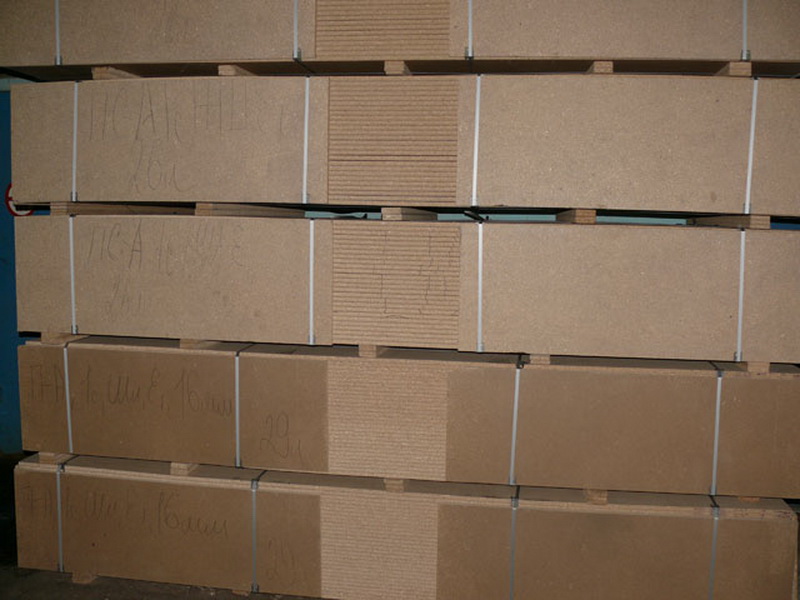Wood particle boards for general and special purposes are made by hot pressing of wood particles mixed with a binder. Wood particle boards are produced on the “Schenk” molding and pressing line, equipped with the “Becker-Van-Hullen” press (Germany). In 2004, the products were certified for compliance with the international standard requirements ISO 9001-2001, in 2005 they were certified according to the international standards of the ISO14000 series, in 2009 the occupational health and safety management system was introduced, meeting the requirements
of OHSAS-18001: 1999, NEQ.
Technological wood raw materials, sawdust and shavings are used as a raw feedstock. А low-toxic carbamide-formaldehyde KF-NFP resin is used аs a binder. The binder also includes a hardener based on ammonium sulfate and additives that reduce the emission of formaldehyde from finished plates, giving the plates special properties, the composition of which is protected by patents.
Wood particle boards GOST 10632-2007 “Particle board. Technical specifications” P-A grades, polished (for the production of furniture, in construction, in mechanical engineering, radio equipment and in the production of packaging);
Wood particle boards PS-A brands are intended for use in residential and civil construction for the production of built-in furniture, window boards, wall panel elements, floor coverings, formwork panels, temporary structures.
Wood particle boards GOST 10632-2007 grades P-A, (B) with increased moisture resistance, sanded. Thanks to special additives, they have increased resistance to both atmospheric moisture and moisture present in the place of use of products made of special-purpose plates.
Laminated pressed wood-fiber board laminated with decorative films chipboard grade P-A of all thicknesses, and increased moisture resistance. Laminated boards have a matte surface, a wide range of decors.
Polish chipboard plate is one of the most popular materials in furniture manufacturing. It can be used both in raw form and for lamination. This plate is made by pressing sawdust and shavings of coniferous and hardwoods mixed with hydrophobizing, antiseptic and other elements at high temperature. After crimping the edges of the plate are processed and the surface is sanded. Polish chipboard has high strength, resistance to mechanical damage, ease of processing and affordable price. Chipboard is widely used in completion and repair works, furniture production, etc.
Polish chipboard – excellent quality at an affordable price!
Width — 1830 mm,
Length — 2440-3660 mm,
Thickness — 8-28 mm,
Density — 638-737 kg / m3,
Humidity — 5-13%,
Swelling in 24 hours — no more than 20%,
Bending strength — 14.2-19.4 MPa,
Tensile strength — 0.27-0.5 MPa,
Surface roughness after grinding — up to 32 microns,
Formaldehyde emission class E1 — less than 8 mg/10.
For avoiding of mechanical damage while loading and transportation, plates stacked in the following amounts:
P mark plate, thickness: 10±0,3 mm — 46 PCs
P mark plate, thickness: 12±0.3 mm — 39 PCs
P mark plate, thickness: 16±0,3 mm — 29 PCs
P mark plate, thickness: 18±0.3 mm — 26 PCs
P mark plate, thickness: 22±0,3 mm — 22 PCs
P mark plate, thickness: 24±0.3 mm — 20 PCs
P mark plate, thickness: 26±0.3 mm — 18 PCs
PS mark plate, thickness: 18±0.8 mm — 26 PCs
Packs of plates are lined with packing plates made of chipboard waste and then tightened with a packing tape (2 longitudinal and 4 transverse belts).




